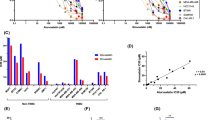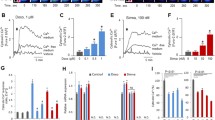Abstract
Tamoxifen has been the mainstay of endocrine therapy for estrogen receptor-positive breast cancer. However, approximately 40% of breast cancer patients do not respond to tamoxifen treatment. Further, most tumors eventually acquire tamoxifen resistance. Therefore, it is necessary to develop effective modalities to enhance the efficacy of tamoxifen in breast cancer treatment. In this study, we investigated the mechanism by which breast cancer cells develop resistance against tamoxifen from the viewpoint of tamoxifen-induced apoptosis. Overexpression of the anti-apoptotic molecule survivin rendered the human breast cancer cells MCF-7 resistant to tamoxifen-induced apoptosis. To examine whether the down-regulation of survivin can enhance tamoxifen-induced apoptosis, we introduced siRNA targeting the survivin gene (survivin-siRNA) into MCF-7 cells. Survivin-siRNA transfection not only induced apoptosis without tamoxifen treatment but also augmented the tamoxifen-induced apoptosis. We have previously demonstrated that 3-hydroxy-3-methylglutaryl coenzyme A reductase inhibitors (HRIs), which are widely used to reduce the serum cholesterol levels in hypercholesterolemia patients, decreases survivin expression in colon cancer cells. To develop a pharmacological approach for improving the efficacy of tamoxifen treatment, we determined whether HRIs can enhance tamoxifen-induced apoptosis. Lovastatin, an HRI, down-regulated the expression of survivin protein in MCF-7 cells in a dose-dependent manner. In addition, the proportion of apoptotic cells induced by the tamoxifen and lovastatin combination was greater than the theoretical additive effect. These results suggest that survivin may function as a factor inducing resistance against tamoxifen-induced apoptosis, and the combined use of tamoxifen and HRI may be a novel approach to overcome tamoxifen resistance in breast cancer.





Similar content being viewed by others
References
Early Breast Cancer Trialists’ Collaborative Group (1998) Tamoxifen for early breast cancer: an overview of the randomised trials. Lancet 351:1451–1467. doi:10.1016/S0140-6736(97)11423-4
Jaiyesimi IA, Buzdar AU, Decker DA, Hortobagyi GN (1995) Use of tamoxifen for breast cancer: twenty-eight years later. J Clin Oncol 13:513–529
Muss HB (1992) Endocrine therapy for advanced breast cancer: a review. Breast Cancer Res Treat 21:15–26. doi:10.1007/BF01811960
Normanno N, Di Maio M, De Maio E, De Luca A, de Matteis A, Giordano A, Perrone F, NCI-Naple Breast Cancer Group (2005) Mechanisms of endocrine resistance and novel therapeutic strategies in breast cancer. Endocr Relat Cancer 12:721–747. doi:10.1677/erc.1.00857
Mandlekar S, Kong AN (2001) Mechanisms of tamoxifen-induced apoptosis. Apoptosis 6:469–477. doi:10.1023/A:1012437607881
Mandlekar S, Hebbar V, Christov K, Kong AN (2000) Pharmacodynamics of tamoxifen and its 4-hydroxy and N-desmethyl metabolites: activation of caspases and induction of apoptosis in rat mammary tumors and in human breast cancer cell lines. Cancer Res 60:6601–6606
Thiantanawat A, Long BJ, Brodie AM (2003) Signaling pathways of apoptosis activated by aromatase inhibitors and antiestrogens. Cancer Res 63:8037–8050
Mandlekar S, Yu R, Tan TH, Kong AN (2000) Activation of caspase–3 and c-Jun NH2-terminal kinase-1 signaling pathways in tamoxifen-induced apoptosis of human breast cancer cells. Cancer Res 60:5995–6000
Saikumar P, Dong Z, Mikhailov V, Denton M, Weinberg JM, Venkatachalam MA (1999) Apoptosis: definition, mechanisms, and relevance to disease. Am J Med 107:489–506. doi:10.1016/S0002-9343(99)00259-4
Shin S, Sung BJ, Cho YS, Kim HJ, Ha NC, Hwang JI et al (2001) An anti-apoptotic protein human survivin is a direct inhibitor of caspase-3 and -7. Biochemistry 40:1117–1123. doi:10.1021/bi001603q
Tamm I, Wang Y, Sausville E, Scudiero DA, Vigna N, Oltersdorf T et al (1998) IAP-family protein survivin inhibits caspase activity and apoptosis induced by Fas (CD95), Bax, caspases, and anticancer drugs. Cancer Res 58:5315–5320
Asanuma K, Kobayashi D, Furuya D, Tsuji N, Yagihashi A, Watanabe N (2002) A role for survivin in radioresistance of pancreatic cancer cells. Jpn J Cancer Res 93:1057–1062
Law M, Rudnicka AR (2006) Statin safety: a systematic review. Am J Cardiol 97:52C–60C. doi:10.1016/j.amjcard.2005.12.010
Holstein SA, Wohlford-Lenane CL, Hohl RJ (2002) Isoprenoids influence expression of Ras and Ras-related proteins. Biochemistry 41:13698–13704. doi:10.1021/bi026251x
Goldstein JL, Brown MS (1990) Regulation of the mevalonate pathway. Nature 343:425–430. doi:10.1038/343425a0
Newman CM, Magee AI (1993) Posttranslational processing of the ras superfamily of small GTP-binding proteins. Biochim Biophys Acta 1155:79–96
Hancock JF, Magee AI, Childs JE, Marshall CJ (1999) All ras proteins are polyisoprenylated but only some are palmitoylated. Cell 57:1167–1177. doi:10.1016/0092-8674(89)90054-8
Vojtek AB, Der CJ (1998) Increasing complexity of the Ras signaling pathway. J Biol Chem 273:19925–19928. doi:10.1074/jbc.273.32.19925
Shaw RJ, Cantley LC (2006) Ras, PI(3)K and mTOR signalling controls tumour cell growth. Nature 441:424–430. doi:10.1038/nature04869
Kaneko R, Tsuji N, Asanuma K, Tanabe H, Kobayashi D, Watanabe N (2007) Survivin down-regulation plays a crucial role in 3-hydroxy-3-methylglutaryl coenzyme A reductase inhibitor-induced apoptosis in cancer. J Biol Chem 282:19273–19281. doi:10.1074/jbc.M610350200
Asanuma K, Tsuji N, Endoh T, Yagihashi A, Watanabe N (2004) Survivin enhances Fas ligand expression via up-regulation of specificity protein 1-mediated gene transcription in colon cancer cells. J Immunol 172:3922–3929
Endoh T, Tsuji N, Asanuma K, Yagihashi A, Watanabe N (2005) Survivin enhances telomerase activity via up-regulation of specificity protein 1- and c-Myc-mediated human telomerase reverse transcriptase gene transcription. Exp Cell Res 305:300–311. doi:10.1016/j.yexcr.2004.12.014
Mahotka C, Wenzel M, Springer E, Gabbert HE, Gerharz CD (1999) Survivin-deltaEx3 and survivin-2B: two novel splice variants of the apoptosis inhibitor survivin with different antiapoptotic properties. Cancer Res 59:6097–6102
Taylor IW, Hodson PJ, Green MD, Sutherland RL (1983) Effects of tamoxifen on cell cycle progression of synchronous MCF-7 human mammary carcinoma cells. Cancer Res 43:4007–4010
Osborne CK, Boldt DH, Clark GM, Trent JM (1983) Effects of tamoxifen on human breast cancer cell cycle kinetics: accumulation of cells in early G1 phase. Cancer Res 43:3583–3585
Williams NS, Gaynor RB, Scoggin S, Verma U, Gokaslan T, Simmang C et al (2003) Identification and validation of genes involved in the pathogenesis of colorectal cancer using cDNA microarrays and RNA interference. Clin Cancer Res 9:931–946
Tsuji N, Asanuma K, Kobayashi D, Yagihashi A, Watanabe N (2005) Introduction of a survivin gene-specific small inhibitory RNA inhibits growth of pancreatic cancer cells. Anticancer Res 25:3967–3972
Dietze EC, Caldwell LE, Grupin SL, Mancini M, Seewaldt VL (2001) Tamoxifen but not 4-hydroxytamoxifen initiates apoptosis in p53(-) normal human mammary epithelial cells by inducing mitochondrial depolarization. J Biol Chem 276:5384–5394. doi:10.1074/jbc.M007915200
Hirsch T, Susin SA, Marzo I, Marchetti P, Zamzami N, Kroemer G (1998) Mitochondrial permeability transition in apoptosis and necrosis. Cell Biol Toxicol 14:141–145. doi:10.1023/A:1007486022411
Fulda S, Scaffidi C, Susin SA, Krammer PH, Kroemer G, Peter ME et al (1998) Activation of mitochondria and release of mitochondrial apoptogenic factors by betulinic acid. J Biol Chem 273:33942–33948. doi:10.1074/jbc.273.51.33942
Li P, Nijhawan D, Budihardjo I, Srinivasula SM, Ahmad M, Alnemri ES et al (1997) Cytochrome c and dATP-dependent formation of Apaf-1/caspase-9 complex initiates an apoptotic protease cascade. Cell 91:479–489. doi:10.1016/S0092-8674(00)80434-1
Mandlekar S, Yu R, Tan TH, Kong AN (2000) Activation of caspase-3 and c-Jun NH2-terminal kinase-1 signaling pathways in tamoxifen-induced apoptosis of human breast cancer cells. Cancer Res 60:5995–6000
Janicke RU, Ng P, Sprengart ML, Porter AG (1998) Caspase-3 is required for alpha-fodrin cleavage but dispensable for cleavage of other death substrates in apoptosis. J Biol Chem 273:15540–15545. doi:10.1074/jbc.273.25.15540
Kisanga ER, Gjerde J, Guerrieri-Gonzaga A, Pigatto F, Pesci-Feltri A, Robertson C et al (2004) Tamoxifen and metabolite concentrations in serum and breast cancer tissue during three dose regimens in a randomized preoperative trial. Clin Cancer Res 10:2336–2343. doi:10.1158/1078-0432.CCR-03-0538
Thibault A, Samid D, Tompkins AC, Figg WD, Cooper MR, Hohl RJ et al (1996) Phase I study of lovastatin, an inhibitor of the mevalonate pathway, in patients with cancer. Clin Cancer Res 2:483–491
Larner J, Jane J, Laws E, Packer R, Myers C, Shaffrey M (1998) A phase I-II trial of lovastatin for anaplastic astrocytoma and glioblastoma multiforme. Am J Clin Oncol 21:579–583. doi:10.1097/00000421-199812000-00010
Kim WS, Kim MM, Choi HJ, Yoon SS, Lee MH, Park K et al (2001) Phase II study of high-dose lovastatin in patients with advanced gastric adenocarcinoma. Invest New Drugs 19:81–83. doi:10.1023/A:1006481423298
Schachter M (2005) Chemical, pharmacokinetic and pharmacodynamic properties of statins: an update. Fundam Clin Pharmacol 19:117–125
Author information
Authors and Affiliations
Corresponding author
Additional information
Naoki Tsuji substantially contributed to this work and should also be considered a first author.
Rights and permissions
About this article
Cite this article
Moriai, R., Tsuji, N., Moriai, M. et al. Survivin plays as a resistant factor against tamoxifen-induced apoptosis in human breast cancer cells. Breast Cancer Res Treat 117, 261–271 (2009). https://doi.org/10.1007/s10549-008-0164-5
Received:
Accepted:
Published:
Issue Date:
DOI: https://doi.org/10.1007/s10549-008-0164-5




